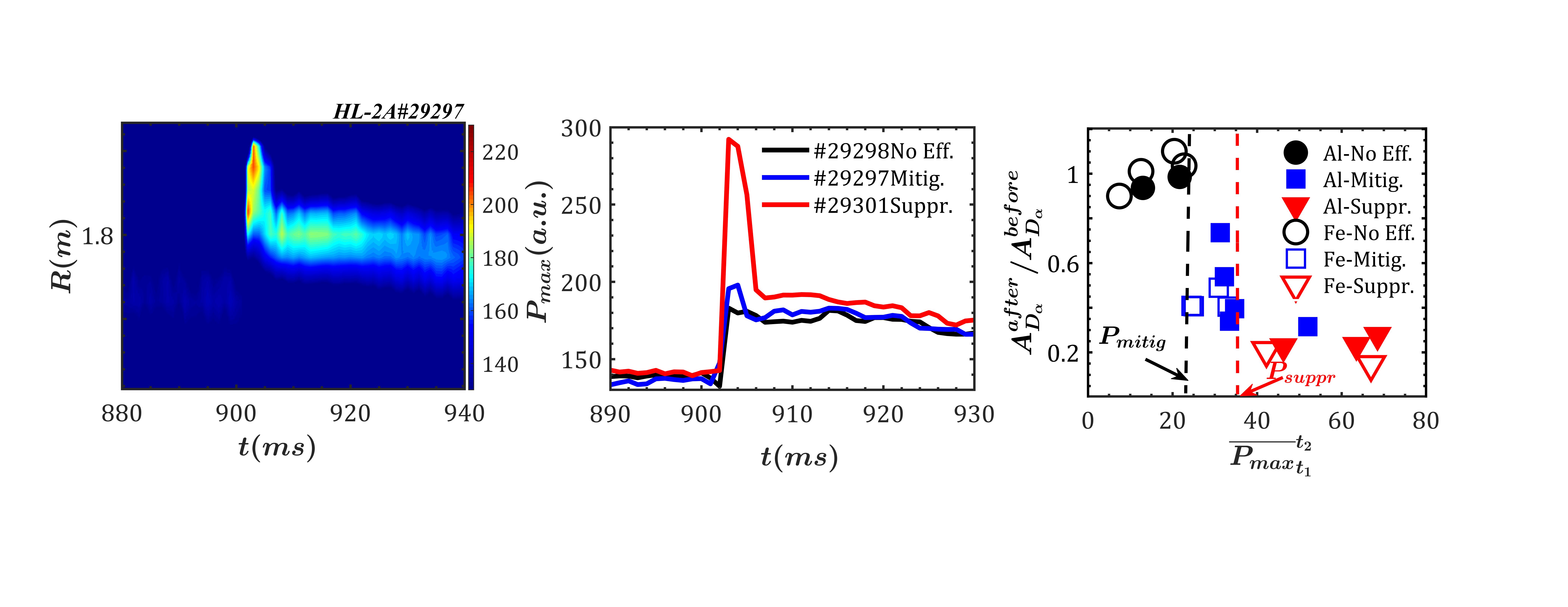Speaker
Description
The control of edge localized mode is crucial for protecting the plasma facing components in the magnetic fusion reactor. In the investigation of ELM control, it has been commonly observed that the pedestal turbulence enhances during edge localized mode (ELM) mitigation with supersonic molecular beam injection (SMBI) [1], lower hybrid current drive (LHCD) [2] and impurity seeding [3][4]. The enhancement of the turbulence with LHCD is interpreted by the radial wavenumber spectral shift of turbulence on HL-2A [2]. It seems that a common model of the turbulence enhancement could be used for the ELM control with these external source inputs [5]. However, the reduction of the turbulence intensity observed during ELM suppression with LBO impurity seeding indicates that the turbulence variation during these two phases should result from different mechanism.

Previous result roughly shows the effect of the quantity of the seeded impurities on ELMs, where the quantity is estimated by the diameter of the laser pot of the LBO system [4]. However, this estimation could be inaccurate respecting that the energy of the laser source is not always the same. In further investigation, the maximum value of the radial profile of radiation power density $P_{max}$ is used to indicate the quantity of the seeded impurities. Its time averaged value $\overline{P_{max}}^{t_2}_{t_1}$ is used for statistical research concerning the crucial role of the impurity transport. Here,$t_1$ is the time when the radiation starts to increase and $t_2$ is the time when the mitigation or suppression ends. It has been found that two thresholds of the impurity density exist for ELM control in the normalized statistic result as shown in Figure I. There is no effect on the ELMs when $\overline{P_{max}}^{t_2}_{t_1} \leq P_{mitig}\simeq 20$, whereas ELMs would be mitigated when $ P_{mitig} \leq\overline{P_{max}}^{t_2}_{t_1} \leq P_{Suppr}\simeq 40$, and the ELMs could be suppressed when $\overline{P_{max}}^{t_2}_{t_1} \geq P_{suppr}\simeq 40$.

In addition, contrary effects of the LBO impurity seeding have been found on the pedestal turbulence, which are due to different mechanisms. During ELM mitigation by impurities, it has been found that the turbulence intensity is increased by reducing the pedestal shear rate, which is similar to the results of the ELM mitigation experiments with LHCD [2]. It has been shown that the modification of the pedestal shear rate by LHCD is due to its ion diamagnetic term $\nabla(\nabla P_i/n_iq_i)$. However, it has been demonstrated that the reduction of pedestal $v_{E \times B}$ shear rate by impurity seeding is attributed to its toroidal velocity term $\nabla(v_{\Phi}B_{\theta})$ in which the ion toroidal velocity $v_{\Phi}$ is increased. Unexpectedly, the ions are accelerated in the toroidal direction, although the flow damping should be enhanced due to the increasing of the electron-ion collision rate by impurity seeding. Good agreement has been found between the experimental observation and simulation result on the turbulence behavior as shown in Figure II. During ELM suppression, the pedestal turbulence is significantly reduced. This reduction of the turbulence could result from the decreasing of the linear growth rate of the ITG mode as predicted by the theoretical simulation [6]. The dual effects of impurity on the pedestal turbulence dominate separately during the ELM mitigation phase and ELM suppression phase. Hitherto, results from HL-2A show a potential approach to control the ELMs by regulation of the pedestal turbulence when appropriately controlling the spatial distribution and quantity of the impurity at the pedestal. Furthermore, the understanding of the unexpected acceleration of the ions in toroidal direction when the electron-ion collision rate increases is a crucial issue, which would be the priority of our research on the next step.
References
[1] W.W. Xiao et al., Nucl. Fusion 52, 114027 (2012)
[2] G.L. Xiao et al., Nucl. Fusion 59, 126033(2019)
[3] Y.P. Zhang et al., Nucl. Fusion 58, 046018 (2018)
[4] W.L. Zhong et al., Nucl. Fusion 59, 076033 (2019)
[5] G.L. Xiao et al., Phys. Plasmas 26, 072303 (2019)
[6] J.Q. Dong et al., Phys. Plasmas 2, 3412(1995)
| Affiliation | Southwestern Institute of Physics |
|---|---|
| Country or International Organization | China |
